Presentation of Fairness Opinion to
Maxum, LLC theGeneral Partnerof
Biggest Little Investments L.P.
May 22, 2013
This material has been prepared by Houlihan Capital, LLC (“Houlihan”) as part of a presentation being made to Maxum, LLC (“Maxum” or the “General Partner”), the general partner to Biggest Little Investments L.P. (“BLI” or the “Company” or the “Partnership”) in support of our opinion of fairness, from a financial point of view (the “Opinion”), as of the date hereof (the “Date of Value”), for the General Partner’s consideration with respect to a potential transaction pursuant to which the Partnership would implement a reverse split of its limited partnership interest units (“Units”) on the basis of one new Unit for each 100 issued and outstanding Units, thereafter limited partners owning less than 100 Units would have their Units cancelled and converted into the right to receive cash consideration of one-hundred twenty dollars ($120.00) per pre-split Unit (the “Transaction”).
Our analyses contained herein are confidential and for the use of the General Partner. Any publication or use of this material or the analyses contained herein without the express written consent of Houlihan is strictly prohibited. Notwithstanding the foregoing, we understand this presentation may be included as an attachment to the Company’s filings with the U.S. Security and Exchange Commission (the “SEC”) related to the Transaction, if it does take place. This Opinion is delivered to each recipient subject to the conditions, scope of engagement, limitations and understandings set forth in the Opinion and subject to the understanding that the obligations of Houlihan and any of its affiliates in the Transaction are solely corporate obligations, and no officer, director, employee, agent, shareholder, or controlling person of Houlihan or any of its affiliates shall be subjected to any personal liability whatsoever to any person, nor will any such claim be asserted by or on behalf of you or your affiliates against any such person with respect to the Opinion other than Houlihan.
Among the activities conducted in the course of our engagement as financial advisor, Houlihan received and reviewed business and financial information provided by BLI or the General Partner in connection with the analyses contained herein. We have not independently verified any such information and have relied on all such information as being complete and accurate in all material respects.
Several analytical methodologies have been employed herein and no one method of analysis should be regarded as critical to the overall conclusion we have reached. Each analytical technique has inherent strengths and weaknesses, and the nature of the available information may further affect the value of particular techniques. The conclusions that we have reached are based on all of the analyses and factors presented herein taken as a whole and also on application of our own experience and judgment. Such conclusions may involve significant elements of subjective judgment or qualitative analysis. We therefore give no opinion as to the value or merit standing alone of any one or more parts of the material that follows.
Our only opinion is the formal written Opinion that we have expressed as to the fairness of the Transaction, from a financial point of view, to the existing limited partnership Unit-holders of BLI. The Opinion, the analyses contained herein, and all conclusions drawn from such analyses are necessarily based upon market, economic, and other conditions that existed and could be evaluated as of the date of this presentation.
Executive Summary 4 4
Background 4
Houlihan Process and Approach 5
Conclusion 9
Due Diligence Procedures 10
Company Overview 12
Transaction Overview 22
Fairness Analysis 23
Existing Terms of the Limited Partnership Units 23
Guideline Public Company Method 25
Comparable Transactions Method 31
Discounted Cash Flow Method 35
Fairness Analysis Conclusion 43
Conclusion 44
Exhibit A: Guideline Public Company Descriptions 49
Exhibit B: Comparable Transactions Target Company Descriptions
Background
| · | Houlihanunderstands that the Partnershipiscontemplating a potential transaction pursuant to which the Partnership would implement a reverse split of its limited partnership Units on the basis of one new Unit for each 100 issued and outstanding Units, thereafter limited partners owning less than 100 Units would have their Units cancelled and converted into the right to receive cash consideration of one-hundred twenty dollars ($120.00) per pre-split Unit. |
| · | Houlihan also understands that the purpose of the Transaction is to reduce the number of Unit-holders to allowBLI to become a privately-held entity not subject to the reporting requirements of U.S. federal securities law. If the Transaction becomes effective, the Partnership intends to terminate the registration of its Units with the SEC. Upon termination of such registration, the Partnership will no longer file periodic reports with the SEC, including Annual Reports on Form 10-K, Quarterly Reports on Form 10-Q, and Current Reports on Form 8-K. |
| · | Houlihanunderstands that if the Transaction becomes effective, the Partnershipexpectsits business and operations generally to continue as they are currently being conducted prior to effecting the Transaction. |
| · | Houlihan has been retained by the General Partner to render an Opinion to the General Partner as to whether, as of the date of such Opinion, the Transaction is fair, from a financial point of view, to the existing Unit-holders of the Partnership. |
| · | Houlihanis regularly engaged in the valuation of businesses and securities in connection with mergers and acquisitions, underwritings, private placements, bankruptcy, capital restructuring, solvency analyses, stock buybacks and valuations for corporate and other purposes. Houlihan has received a non-contingent fee from the General Partner relating to its services in providing the Opinion. In an engagement letter executed on May 9, 2013,the General Partner has agreed to indemnify Houlihan with respect to Houlihan’s services performed relating to the Opinion. |
Houlihan Process and Approach
| · | Houlihan was engaged to provide a fairness opinion to the General Partner regarding the fairness of the Transaction, from a financial point of view, to the existing Unit-holders of the Partnership. |
| · | Houlihan conducted due diligence in order to identify key issues and parties involved, address potential conflicts of interest and related parties, and identify methods of analyses to be considered in the Opinion. |
| · | Houlihan analyzed the proposed structure of the Transaction and corresponding value to be realized by the existing Unit-holders of the Partnership. |
| · | As addressed further herein, Houlihan analyzed internal and external factors which could influence the value of theUnits and performed such other analyses deemed appropriate and consistent with accepted business valuation techniques, including, but not necessarily limited to, the following: |
| o | Information provided by certain members of BLI’s senior management (“Management”) regarding the potential Transaction and the outlook for the Partnership, including for a discounted cash flow analysis; |
| o | The prior five years of historical financial results for the Partnership, as filed with the SEC, as well as Management-projected financial results for the fiscal years ending December 31, 2013 through 2017; |
| o | Information regarding guideline publicly traded companies considered similar to the Partnership; and |
| o | Information regarding transactions involving target companies considered similar to the Partnership. |
| · | Houlihan prepared its Opinion and conducted an internal fairness committee meeting in order to assess the fairness of the Transaction.
|
Houlihan Process and Approach (continued)
In performing its analysis, Houlihan also considered the following factors which are typically important in the analysis of a going-private transaction according to the SEC’s schedule 13E-3:
| · | Current market prices of the Units; |
| · | Historical market prices of the Units; |
| · | The net book value of the Partnership; |
| · | The going concern value of the Partnership; |
| · | The liquidation value of the Partnership; |
| · | The price paid for Units in purchases by the Partnership or its affiliates over the previous two fiscal years; |
| · | Reports, opinions, or appraisals received by the Partnership or its affiliates relating to the Transaction’s fairness; and |
| · | Firm offers during the preceding two years for merger, consolidation, or sale of assets of the Partnership, or for securities of the Partnership sought in order to exercise control. |
Houlihan Process and Approach (continued)
Houlihan’s Opinion addresses only the fairness to the Partnership’sexisting Unit-holders, from a financial point of view, of the Transaction. Houlihan was not requested to opine as to, and its Opinion does not address:
| · | the underlying business decision of the Partnership, the Partnership’s security holders or any other party to proceed with or effect the proposed Transaction; |
| · | the fairness of any portion or aspect of the proposed Transaction not expressly addressed in its Opinion; |
| · | the terms of the Transaction (except as expressly set forth in its Opinion as to the fairness, from a financial point of view, of the Transaction), including without limitation the closing conditions and other provisions thereof; |
| · | the fairness of any portion or aspect of the proposed Transaction to the holders of any securities, creditors, or other constituencies of the Partnership, or any other party other than those set forth in its Opinion; |
| · | the relative merits of the proposed Transaction as compared to any alternative business strategies that might exist for the Partnershipor the effect of any other transaction in which the Partnership might engage; or |
| · | the tax or legal consequences of the proposed Transaction to eitherthe Partnership, its security holders, or any other party. |
Houlihan Process and Approach (continued)
Furthermore, no opinion, counsel, or interpretation was intended in matters that require legal, regulatory, accounting, insurance, tax, or other similar professional advice.
Houlihan was not requested to make, and did not make, any physical inspection or independent appraisal or evaluation of any of the assets, properties, or liabilities (contingent or otherwise) of the Partnership, nor was Houlihan provided with any such appraisal or evaluation.
Houlihan was not requested to, and did not:
| · | initiate any discussions with, or solicit any indications of interest from, third parties with respect to the Transaction or any alternatives to the proposed Transaction; |
| · | negotiate the terms of the proposed Transaction; or |
| · | advisethe General Partner with respect to alternatives to the proposed Transaction. |
Houlihan’s opinion is necessarily based on financial, economic, market and other conditions as in effect on, and the information made available to it as of, the date of its Opinion. Houlihan is under no obligation, to update, revise, reaffirm or withdraw its Opinion, or otherwise comment on or consider events occurring after the date of its Opinion.
Conclusion
| · | It is Houlihan’s opinion that, as of the date hereof, the Transaction is fair, from a financial point of view, to the existing limited partnership Unit-holders of BLI. |

Due Diligence Procedures
In completing our analyses and for purposes of the Opinion set forth herein, Houlihan has, among other things, performed the following procedures.
| · | Houlihan held discussions and had other communications with certain members of Management regarding the potential Transaction, as well as the historical financial results of and the outlook for the Partnership’s business. |
| · | Houlihan reviewed a draftSEC Schedule 13E-3 Transaction Statement document and a draft SEC Schedule 14C Information Statementdocument prepared by Management and outside legal counsel of the Partnership outlining the key termsof the Transaction. |
| · | Houlihan reviewed the SecondAmended and Restated LimitedPartnershipAgreement of BLI (the “Amended LP Agreement”), dated October 8, 2003, as well as the 1st and 2nd amendments to such, dated September 1, 2005 and June 12, 2009, respectively. |
| · | Houlihan obtained, reviewed, and/or analyzed certain information relating to the historical, current, and future operations of the Partnership on a pro-forma basis including, but not limited to, the following: |
| o | The Partnership's latest reports on SEC Form 10-Q and SEC Form 10-K, as well as other relevant publicly available documents, as filed with the SEC; and |
| o | Projected financial results for the Partnership for the fiscal years ending December 31, 2013 through 2017, including revenues, operating expenses, depreciation expenses, capital expenditures, and current asset and current liability line items.
|
Due Diligence Procedures (continued)
| · | Houlihan reviewed the recent history of the Partnership’s purchase of Units from limited partners pursuant to a tender offer that has been on-going since August of 2009 in which the existing limited partnership Unit-holders maysell their Units back to the Partnership for cash at a price agreed upon with the General Partner (the “Redemption Offer”), including the number of Units purchased and average price paid per Unit for each month of the most recent six months available. |
| · | Houlihan obtained, reviewed, and/or analyzed information regarding the industry in which the Partnership operates, which included a review of, but was not necessarily limited to, the following: |
| o | Certain industry research, such as analyst reports and data available from various financial research databases; |
| o | Information regarding certain guideline publicly traded companies considered reasonably comparable to the Partnership; and |
| o | Information regarding certain publicly disclosed merger and acquisition(“M&A”) transactions involving the purchase of target companies considered reasonably comparable to the Partnership. |
| · | Houlihan reviewed certain other relevant, publicly available information, including economic, industry, and information specific to the Partnership, as deemed reasonable and pertinent to this engagement and the associated analyses. |
| · | Houlihan developed indications of value for the Partnership and the Units using generally accepted valuation methodologies, utilizing information and sources including, but not necessarily limited to, those described above. |
Company Overview
| · | The Partnership, formerly organized as Resources Accrued Mortgage Investors 2, L.P., Resources Accrued Mortgage Investors L.P. Series 87, and Resources Accrued Mortgage Investors L.P. Series 88, was organized as a Delaware limited partnership on August 14, 1986. |
| o | Until January 1, 2002, the general partners of the Partnership were RAM Funding, Inc. (“RAM Funding”) and Presidio AGP Corp. (“Presidio AGP”). |
| o | Effective January 1, 2002, the managing general partner interest and the associate general partner interest were acquired by Maxum (the General Partner). |
| · | On October 8, 2003, the Partnership received consents from the holders of a majority of its outstanding Units to adopt the Amended LP Agreement. |
| o | Pursuant to the Amended LP Agreement, the Partnership was renamed Biggest Little Investments, L.P. |
| o | The Amended LP Agreement also provides the Partnership with the ability to leverage its property in an effort to increase the value of the Partnership, to purchase additional real estate for investment and/or development, and to make or acquire additional mortgage loans or short-term loans, as well as to reinvest operating income and proceeds from the sale or refinancing of its properties or the disposition of its mortgage loans. |
| o | Further, the Amended LP Agreement permits the Partnershipto repurchase Units from the limited partners of BLI. |
Company Overview (continued)
| · | On June 12, 2009, the Amended LP Agreement was amended (the “Second Amendment) to permit the Partnership to invest in any personal property or other non-real estate assets and to invest in joint ventures, partnerships, firms, corporations, or other entities where the Partnership would not have a controlling interest in such entities. |
| o | Prior to the Second Amendment, the Amended LP Agreement limited the Partnership to investments in mortgage notes or real estate assets and to investing in entities only where it would acquire a controlling interest in such entities. |
| o | The Second Amendment also extended the term of the Partnership to December 31, 2030. Prior to the Second Amendment, the term of the Partnership was scheduled to expire on December 31, 2016. |
| · | The Partnership's sole property is a shopping center commonly known as the Sierra Marketplace(the “Sierra Property”)located at the corner of South Virginia Street and East Moana Lane in Reno, Nevada, one of the busiest intersections in Reno. The Partnership owns the Sierra Property in fee simple and the Sierra Property is not subject to any mortgages, liens or other encumbrances. The General Partner believes that the Sierra Property is adequately covered by insurance. |
| · | The real estate business is highly competitive and the Sierra Property has active competition for tenants from similar properties in the vicinity. |
| · | The Partnership has four employees; three employees work full time and one works part time. The business of the Partnership is managed by the General Partner and its affiliates and agents. |
| · | The principal executive offices of the Partnership are located at 3702 S. Virginia Street, Unit G2, Reno, Nevada 89502.
|
Company Overview (continued)
| Ø | Investments of the Partnership |
| · | The Partnership had an investment in a mortgage loan (the “Sierra Loan”) issued in 1989 in the amount of $6,500,000 to a public limited partnership. On March 3, 2003, the Partnership acquired the deed to the Sierra Property securing the Sierra Loan, in lieu of foreclosing on the Sierra Loan. |
| o | The Sierra Property consists of approximately 210,000 square feet of net rentable area and occupies 18.44 acres, consisting primarily of two main buildings with spaces for two anchor tenants, with surface parking for approximately 1,000 automobiles (please see the photograph on the following page for illustration, with the dashed red lines indicating the approximate boundaries of the Sierra Property). |
| · | The Sierra Property is thePartnership’s sole fixed asset, and as of March 31, 2013 had a vacancy rate of approximately 79% based on leasable square footage. The ongoing softness in the overall economy has hurt the retail sector, thus making it difficult to locate new tenants for the Sierra Property. |
| o | Over the past few years, the Sierra Property has lost all of its original anchor tenants and due, in part, to extensive competition for tenants, has not been able to sign new anchor tenants to similar lease terms. |
| o | One of the anchor tenant spaces was demolished for the purpose of creating in its place a new driveway (and traffic signal) directly between the Sierra Property and the hotel casino property next to the Sierra Property (the “Adjacent Property”), and the portion of the Sierra Property that was demolished has been leased to the owner of the Adjacent Property since September 30, 2004, enabling the Partnership to make up much of the lost rental revenue previously generated by the space. |
| o | The other two anchor tenant spaces are vacant. The Partnership continues to market the Sierra Property, including the two vacant anchor tenant spaces, to potential tenants.
|
Company Overview (continued)

Company Overview (continued)
| · | In 2004, the Partnership began renovation efforts in an attempt to maximize the financial viability of the Sierra Property by demolishing and rebuilding part of the property (the "Renovation"). |
| o | As part of the Renovation, a portion of the shopping center previously occupied by an anchor tenant was demolished for the purpose of creating in its place a new driveway (and traffic signal) directly between the Sierra Property and the Adjacent Property. |
| o | The driveway was constructed and put into use on September 30, 2004, and is being shared by, and provides a connection between, the Sierra Property and the Adjacent Property. |
| o | In January 2004, the Adjacent Property entered into a lease with the Partnership for a 37,368 square foot section of the Sierra Property (including the new driveway). The Adjacent Property has a minimum lease term of 15 years at a current monthly rent of approximately $28,400, subject to increase every 60 months based on the Consumer Price Index. |
| o | The space being leased by the Adjacent Property provides pedestrian and vehicle access to the Adjacent Property, and the Adjacent Property has use of a portion of the parking spaces at the Sierra Property. |
| o | The Adjacent Property also uses part of the common area of the Sierra Property and pays its proportionate share of the common area expense of the Sierra Property. |
| o | The Adjacent Property has the option to renew the lease for three five-year terms, and, at the end of the extension periods, has the option to purchase the leased section of the Sierra Property at a price to be determined based on an MAI Appraisal. |
Company Overview (continued)
| · | On June 8, 2011, the Partnership reached final agreement (the “Agreement”) with and sold to the Regional Transportation Commission (the “RTC”) a portion of the Sierra Property for the purpose of widening a section of Moana Lane, a main thoroughfare in Reno, Nevada on which the Sierra Property is located (the “Widening Project”). |
| o | The Widening Project was completed in November 2012 - Moana Lane was expanded from four to six lanes. |
| o | Under the terms of the Agreement, the RTC paid the Partnership $2,731,787 for causing demolition of up to 15,800 square feet of the Sierra Property’s buildings, the RTC’s acquisition of 25,306 square feet of the Sierra Property’s land, and 10,026 square feet of utility easement. |
| o | The RTC paid the Partnership an additional $346,700 for relocation and demolition costs related to the Sierra Property’s buildings and improvements. |
| o | In September 2012, the Partnership began rebuilding the facade of the Sierra Property’s building that was impacted by the Widening Project. This rebuilding project was completed during the fourth quarter of 2012, and the Partnership funded the cost of this project with the compensation it had received from the RTC. |
| · | The Partnership also holds and trades in various securities of publicly traded companies. |
| o | As of the Date of Value, the Partnership had sizeable holdings in equity securities of Citigroup, Inc., Las Vegas Sands Corp., and MGM Resorts International, as well as in short positions of Apple, Inc. |
| o | The Partnership also held smaller equity and short positions in various other publicly traded companies. |
Company Overview (continued)
| Ø | Unit Sales / Tender Offers and Redemptions |
| · | There is no established public trading market for the Units of the Partnership. |
| · | There were no Units sold by the Partnership during fiscal years 2011 or 2012. |
| · | On August 31, 2009, the Partnership initiated an offer enabling the Partnership's limited partners to sell their Units back to the Partnership. |
| o | The Partnership may repurchase whole Units only, at a price reasonably determined by the General Partner based on market considerations. |
| o | Units repurchased by the Partnership under the Redemption Offer will be canceled, and will have the status of authorized but unissued Units. |
| o | The Partnership's obligation to repurchase any Units under the Redemption Offer is conditioned upon its having sufficient funds available to complete the repurchase. |
| o | The Partnership will use any operating funds as the General Partner, in its sole discretion, may reserve for the purpose of funding the Redemption Offer. |
| o | On August 24, 2012, the Redemption Offer was extended until August 31, 2013, subject to the right of the General Partner to suspend, terminate, modify or extend the term of the Redemption Offer in its sole discretion. |
| o | As of March 31, 2013, an aggregate of 12,358 Units had been repurchased by the Partnership pursuant to the Redemption Offer at an approximate average price of $102.98 per Unit.
|
Company Overview (continued)
| · | The following table provides a summary of Units repurchased by the Partnership pursuant to the Redemption Offer during the six months ending March 31, 2013: |
| BLI Unit Repurchases During the Month Ending | # of Units Repurchased | Average Price Paid per Unit |
| March 31, 2013 | 112 | $113.00 |
| February 28, 2013 | 22 | $109.00 |
| January 31, 2013 | 41 | $103.00 |
| December 31, 2012 | 20 | $103.00 |
| November 30, 2012 | 108 | $103.00 |
| October 31, 2012 | 336 | $103.00 |
| Ø | Summary Demographic Statistics – Reno, Nevada |
| Statistical Measure (2010 Data) | Reno, NV | Nevada | United States |
| Median Household Income | $54,562 | $60,859 | $55,970 |
| Average Household Income | $73,450 | $76,414 | $74,974 |
| Per Capita Household Income | $30,038 | $28,878 | $28,779 |
| Total Population | 213,532 | 2,659,705 | 308,455,134 |
| 2010-14 Population Change (Est.) | 1.42% | 6.11% | 4.52% |
| Median Age | 34.6 | 35.7 | 35.6 |
| Total Crime Risk Index | 114 | 120 | 100 |
Company Overview (continued)
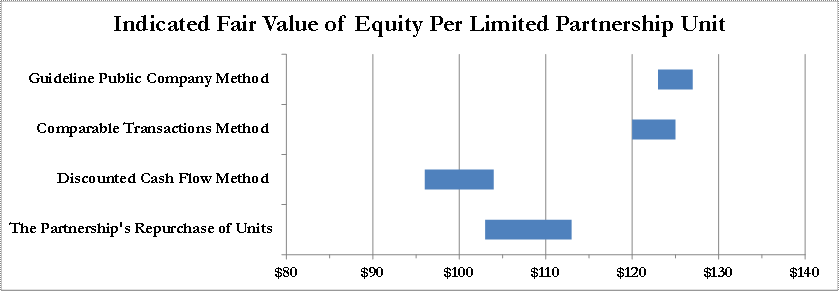
| · | The vast majority of the Partnership’s current assets are comprised of cash and cash equivalents, short-term investments, and available-for-sale securities. |
| · | The Partnership’s only other significant assets are fixed assets, which are comprised of the Sierra Property. |
| · | The Partnership’s net working capital balance is negligible, and historically has been relatively insignificant. |
| · | The Partnership has no debt, and historically has not had any debt (nor does it intend to obtain any debt). |
Company Overview (continued)
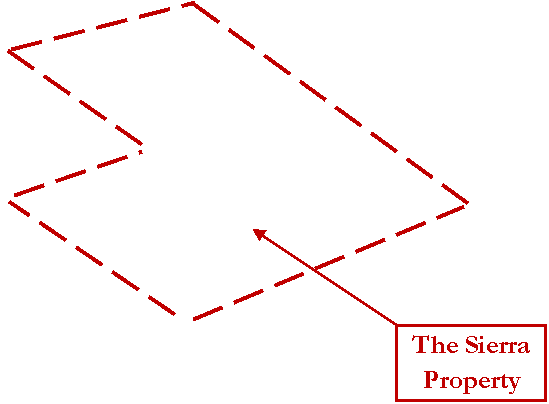
| · | The Partnership’s operating revenues, which are comprised of rental revenues, have decreased in each of the last four fiscal years from 2009 through 2012. |
| o | In 2012, over $520,000 or more than 63% of rental revenues were from the Adjacent Property. |
| o | During the same period, $305,000 or less than 37% of rental revenues were from un-related parties. |
| · | EBITDA from operations has been only slightly positive for the two most recent fiscal years. |
| · | Other income includes interest on cash and cash equivalents, dividends from available-for-sale securities, and certain non-recurring gains and losses, such as loan origination or termination fees, gains/losses on sales of securities, and proceeds received as a result of the Widening Project. |
Transaction Overview
| · | As stated previously, Houlihan understands that the Partnership is contemplating a potential transaction pursuant to which the Partnership would implement a reverse split of its limited partnership Units on the basis of one new Unit for each 100 issued and outstanding Units, thereafter limited partners owning less than 100 Units would have their Units cancelled and converted into the right to receive cash consideration of one-hundred twenty dollars ($120.00) per pre-split Unit. Limited partners owning less than 100 pre-split Units do not have the option to opt-out. |
| · | Houlihan also understands that the purpose of the Transaction is to reduce the number of Unit-holders to allowBLI to become a privately-held entity not subject to the reporting requirements of U.S. federal securities law. If the Transaction becomes effective, the Partnership intends to terminate the registration of its Units with the SEC. Upon termination of such registration, the Partnership will no longer file periodic reports with the SEC, including Annual Reports on Form 10-K, Quarterly Reports on Form 10-Q, and Current Reports on Form 8-K. |
| · | If the Transaction becomes effective, the limited partnershipUnits would continue to have the same rights and preferences under the limited partnership agreementcurrently in force (the Second Amended and Restated Limited Partnership Agreement of BLI); no changes are intended to the nature of the Units or the Partnership’s business. |
| · | If the Transaction becomes effective, the limited partnership Units that remain outstanding would represent an increased ownership percentage in the Partnership, as the Units of limited partners owning less than 100 Units would be cancelled, leaving fewer Units outstanding, and increasing the proportionate stake of then outstanding Units. For example, as a result of the Transaction, the beneficial ownership of Ben Farahi, the largest holder of Units, is expected to increase from approximately 38.9% to approximately 42.4% of the outstanding Units. |
| · | A change of control in ownership is not expected to occur as a result of the Transaction; however, the three largest Unit-holders (including Ben Farahi), who collectively currently own approximately 75% of the Units and are all related, would own an even greater proportion of the then outstanding Units and percentage in the Partnership.
|
Existing Terms of the Limited Partnership Units
The following table provides a summary of the existing terms of the limited partnership Units:
| Name of Partnership: | Biggest Little Investments L.P. |
| Governing Law: | State of Delaware |
| Principal Place of Business: | Reno, Nevada |
| Purpose of the Partnership: | To invest in, hold, sell, dispose of and otherwise act with respect to first and junior mortgage loans on fee or leasehold interests in real property (or the equivalent to such), as well as loans secured by interests in partnerships, real estate investment trusts, joint ventures, or other entities. The Second Amendment permits investments in any personal property or other non-real estate assets, including any partnerships firms, corporations, or other entities where the Partnership would not have a controlling interest. |
| Term: | December 31, 2030, unless previously terminated or extended in accordance with the Partnership Agreement (extended by the Second Amendment; previously was set to expire on December 31, 2016). |
| Units: | Limited Partnership Units |
| Number of Units Outstanding: | 168,049 |
| Allocation of Income/Losses & Distributions: | Except otherwise noted in the Partnership Agreement, Net Income/Losses shall be allocated 97.5% to the Limited Partners and 2.5% to the General Partner, on a pro-rata basis. |
| Voting Rights: | Limited Partners shall have the right, by Majority Vote, to vote upon matters affecting the basic structure of the Partnership. |
| Control: | Limited Partners shall take no part in any manner in the control, conduct or operation of the Partnership and shall have no right or authority to act for or bind the Partnership. |
| Transferability: | A Limited Partner shall have the right to transfer and assign a minimum of 10 whole Units. |
| Redemption: | Neither the Partnership, nor the General Partner or its Affiliates shall be obligated or required to redeem or purchase any Units. However, the Partnership may purchase outstanding Units if such purchase does not impair the capital or operations of the Partnership at a price determined by the General Partner, in its sole discretion, based on market considerations. The Units are currently redeemable per the terms of the Redemption Offer. |
Existing Terms of the Limited Partnership Units(continued)
| · | Houlihan specifically noted that, as of the date hereof, theSierra Property is the Partnership’s sole operating asset, and aside from the Partnership’s cash and securities (discussed immediately below) is the only cash flow generating operating asset of the Partnership from which the Unit-holders can derive expected cash flows. |
| · | In addition, the Company had approximately $9.4 million in cash and cash equivalents on its balance sheet as of the Date of Value, as well as approximately $5.1 million of short-term investments and available for sale securities, the value of which also inure to the limited partnership Unit-holders. |
| o | While these holdings do generate interest, dividends, and certain other cash flows, the market value of these holdings represents the present value of the principle along with any future associated cash flows expected to be derived from these assets; and |
| o | Therefore, no adjustment to the values of these holdings is necessary to determine their value to the limited partnership Unit-holders. |
| · | Houlihan also noted that, while the Unit-holders do have voting rights, they only have the right to vote on “matters affecting the basic structure of the Partnership” and not the operations, investments, or other day-to-day business of the Partnership. |
| o | To this end, the Partnership Agreement states that, “Limited Partners shall take no part in any manner in the control, conduct or operation of the Partnership and shall have no right or authority to act for or bind the Partnership.” |
| · | The Unit-holders do have the right to transfer or assign Units, provided that they do so in quantities of 10 or more whole (pre-split) Units; however, as previously noted, there is no established public market for the Units.
|
Guideline Public Company Method
The Guideline Public Company Method is a valuation technique within theMarket Approach that analyzes transactions in the public equity markets for common stock of companies operating in industriessimilar to that of the Partnership.
While it is generallyagreed that no two companies are exactly alike, consideration is given to the similarity in operations, size, profitability, growth, and risk, as well as other operating characteristics of the guideline public companies to determine an informed estimate of value for a subject company. Houlihan identified 10 guidelinepublic companies that were considered reasonably similar to the Partnership, as of the Date of Value, as presented in the following table.
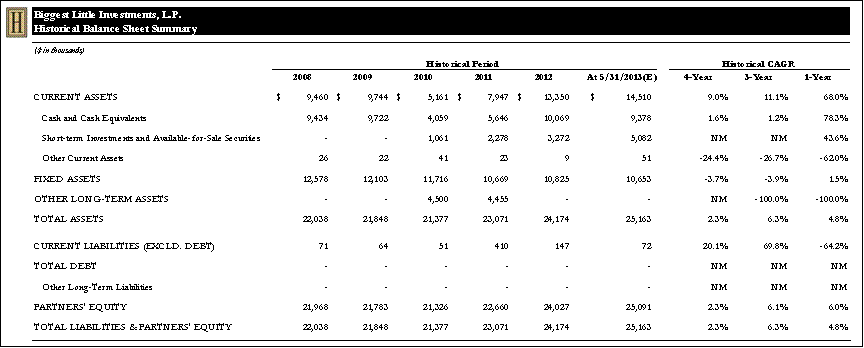
Guideline Public Company Method (continued)
Houlihan noted that these public companies, many of which are publicly-traded Real Estate Investment Trusts (“REITs”) that own and operate shopping malls, among other retail-centered real estate investments and operations,are generally much largerthan BLI, although some of their holdings have a similarproperty description. Houlihan also considered the following factors in selecting multiples for BLI based on the guideline public companies identified.
| · | The vast majority of the relevant shopping and other retail centers owned and operated by the companies within this peer group are located in much more geographically diverse areas of the U.S., including many in or near large metropolitan areas that contain a larger population, more extensive potential market, and more favorable economic conditions than Reno, NV where the Sierra Property is located (i.e., BLI has a higher risk profile). |
| · | BLI’s total assets of approximately $24.7 million is much lower than the $2.62 billion median of this peer group, and is also lower than the 25th percentile of $1.55 billion as well as the minimum of $296 million. |
| · | BLI’s LTM operating (rental) revenue of approximately $0.8 million is much lower than the $390 million median of this peer group, and is also lower than the 25th percentile of $204 million as well as the minimum of $56 million. |
| · | BLI’s LTM operating EBITDA margin of 9.6% is much lower than the 55.6% median of this peer group, and is also lower than the 25th percentile of 53.8% as well as the minimum of 34.2%. |
| · | BLI most likely has less access to capital / financing than this peer group, which is comprised of larger, public companies with access to the capital markets and management teams experienced in the real estate industry. |
| · | However, BLI’s debt ratio of 0% is much lower than any debt measure for this peer group, which is by and large highly leveraged; the median capital structure of the peer group is over 45% debt and the low is 33.6% debt. |
Guideline Public Company Method (continued)
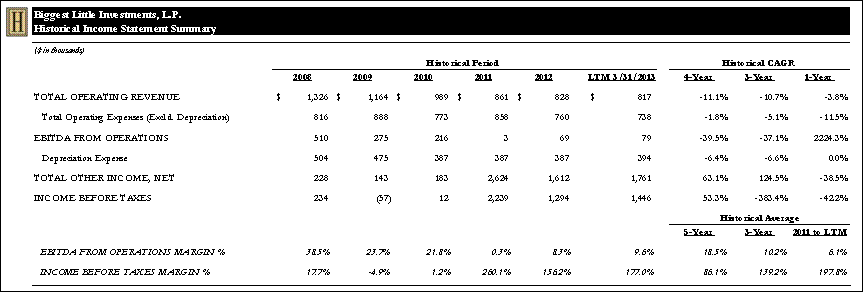
Guideline Public Company Method (continued)
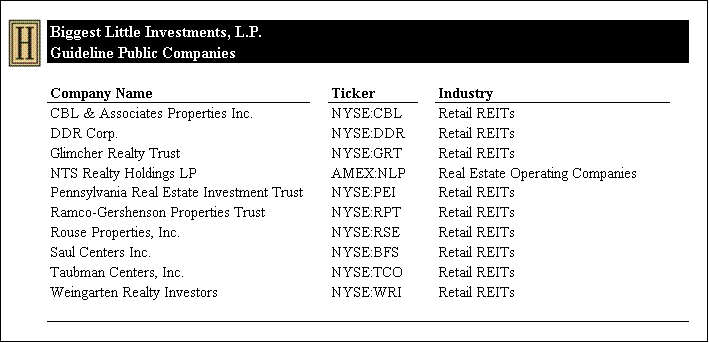
Guideline Public Company Method (continued)
| · | Houlihan concluded that based on the data regarding public trades for the common equity of the guideline public companies, as of the Date of Value, and the considerations noted above, reasonable valuationmultiples to estimate a going-concern value for BLI would approximate a range between the minimum and 25th percentile multiples indicated by the guideline public company peer group identified. |
| · | Houlihan considered applying multiples of the Partnership’s operating revenues and operating EBITDA; however, Houlihan concluded that only revenue multiples were applicable in this instance. |
| o | The Partnership’s operating EBITDA, which is only slightly positive, is in a transitional period and represents a depressed level, compared to the peer group identified, given the Sierra Property’s 79% vacancy rate, causing EBITDA multiples not to produce reliable indications of value. |
| · | Therefore, Houlihancalculateda range of enterprise values indicated by the selected revenue multiples, as shown on the following page, which Houlihan considers to be on a controlling-interest basis, since the Partnership’s financial metrics incorporated within the calculations represent controlling-interest level cash flows. |
| · | Houlihan then added the value of the Partnership’s cash andcash equivalents, short-terminvestments, andavailable-for-sale securities. |
| · | Finally, Houlihan divided by the number of limited partnership Units outstanding to determine a reasonable range of indicated equity values for the Partnership, as presented in the following table. |
Guideline Public Company Method (continued)
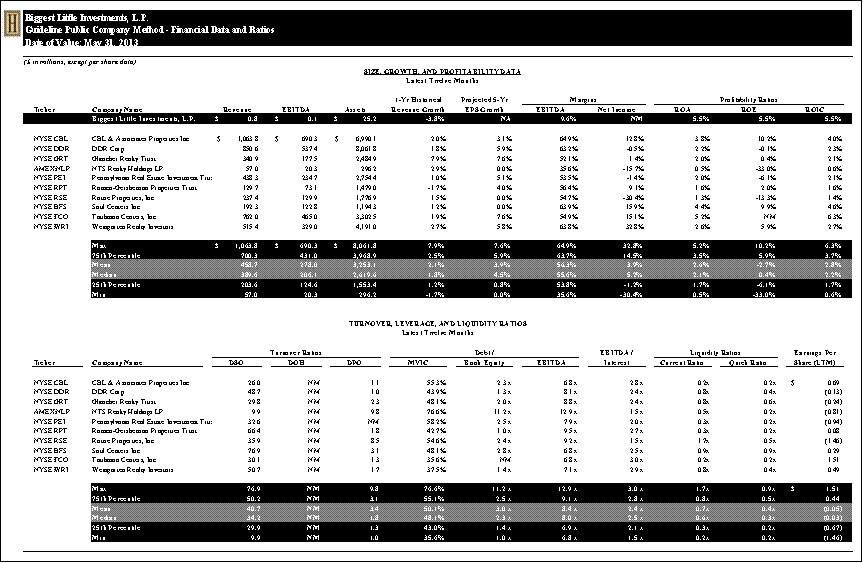
Comparable Transactions Method
The Comparable Transactions Method is a valuation technique within theMarket Approach that analyzes transactions involving mergers and acquisitions for targetcompanies operating in industriessimilar to that of the Partnership.
While it is generallyagreed that no two companies are exactly alike, nor are any two transactions structured exactly the same, consideration is given to the similarity in operations, size, profitability, and risk, as well as other operating characteristics of the target companies to determine an informed estimate of value for a subject company. Houlihan identified11comparabletransactions closed duringthe past three years,as presented on the following page.
Houlihan noted that these target entities, which operate shopping malls in Rocky Mountain states considered comparable to the Sierra Property’s operations,are relatively similarin size and property description. Houlihan also considered the following factors in selecting multiples for BLI based on the comparable transactions identified.
| · | The vast majority of the relevant shopping centers within this peer group are located in or near large metropolitan areas, such as Phoenix (AZ), Tucson (AZ), Denver (CO), and Las Vegas (NV), which contain a larger population, more extensive potential market, and more favorable economic conditions than Reno, NV where the Sierra Property is located (i.e., BLI has a higher risk profile). |
| · | BLI’s LTM operating (rental) revenue of approximately $0.8 million is lower than the $1.3 million median of this peer group, and similar to the 25th percentile of $0.9 million. |
Houlihan noted that it is possible that buyers in M&A transactions anticipate improved operating results and/or synergies after the transaction is completed and therefore may be willing to pay a higher price for the targets than a stand-alone entity value. The buyers may also perceive incremental value in the control that they would be able to exert over the target company in other aspects of operations, financing, or corporate practices. These synergistic and/or control premiums are difficult to quantify explicitly, but the professional valuation community widely recognizes theexistence of such premiums.
Comparable Transactions Method (continued)
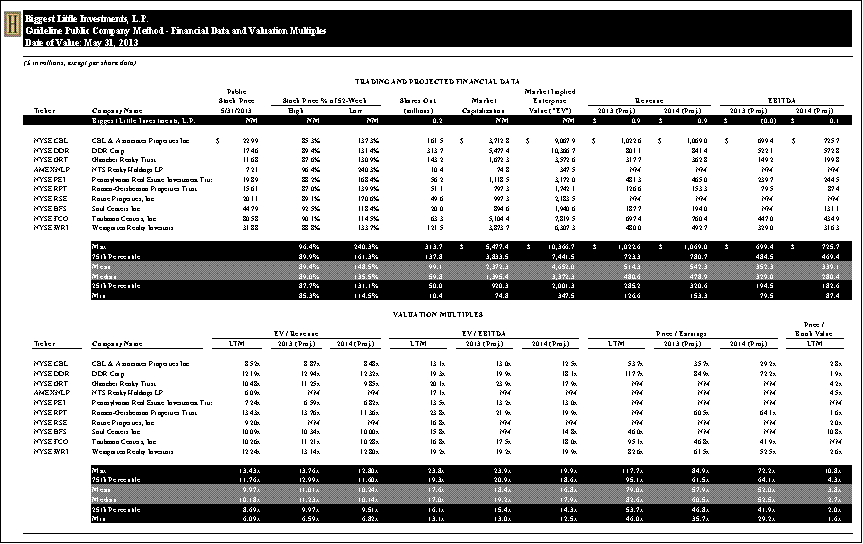
Comparable Transactions Method (continued)
| · | Houlihan concluded that based on the data regarding recently completed M&A transactions for comparable target companies and the considerations noted above, reasonable valuationmultiples to estimate a going-concern value for BLI would approximate a range between the minimum and 25th percentile multiples indicated by the comparable transactions peer group identified. |
| · | Houlihan considered applying multiples of the Partnership’s operating revenues, operating EBITDA, and rentable square feet; however, Houlihan concluded that only revenue multiples were applicable in this instance. |
| o | The Partnership’s operating EBITDA, which is only slightly positive, is in a transitional period and represents a depressed level, compared to the peer group identified, given the Sierra Property’s 79% vacancy rate, causing EBITDA multiples not to produce reliable indications of value; and |
| o | The Sierra Property’s rentable square feet, which is only 21% rented,cannot be translated directly into a reliable indication of value, based on the peer group multiples identified, because vacancy/occupancy rates that could be used to adjust the observed multiples were not available for the target companies. |
| · | Therefore, Houlihancalculateda range of enterprise values indicated by the selected revenue multiples, as shown on the following page, which Houlihan considers to be on a controlling-interest basis, since the Partnership’s financial metrics incorporated within the calculations represent controlling-interest level cash flows. |
| · | Houlihan then added the value of the Partnership’s cash andcash equivalents, short-terminvestments, andavailable-for-sale securities. |
| · | Finally, Houlihan divided by the number of limited partnership Units outstanding to determine a reasonable range of indicated equity values for the Partnership, as presented in the following table. |
Comparable Transactions Method (continued)
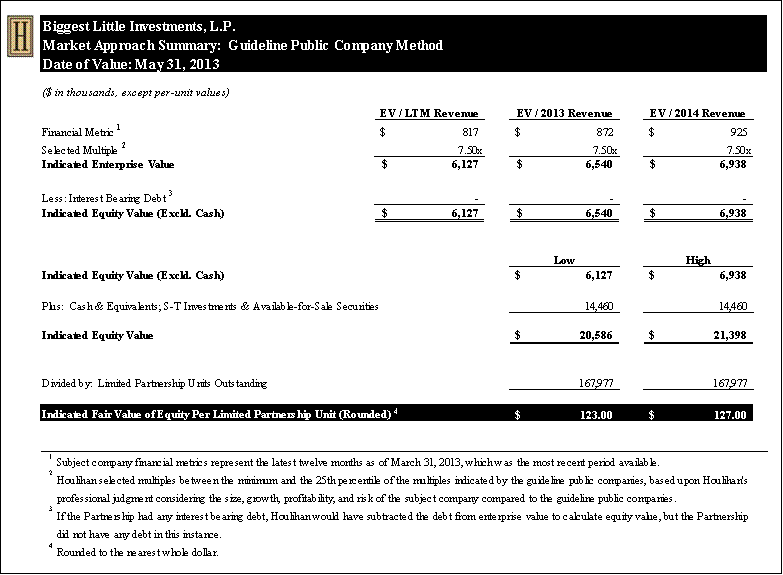
Discounted Cash Flow Method
A well-established technique used to estimate the value of a company is the Discounted Cash Flow (“DCF”) Method of the Income Approach.
| · | Value is indicated by analyzing the future cash flows that are expected to inure to the owners of a company. |
| · | The enterprise value of a company is determined by summing all of the future debt-free cash flows attributable to the company, including an indicated terminal value, discounted to present value at an appropriate required rate of return (discount rate), such as the company’s estimated weighted average cost of capital(“WACC”). |
| · | Then the company’s cash and cash equivalents are added and any interest bearing debt is subtracted to determine the indicated value of the company’s equity. |
The first step within Houlihan’s DCF analysis for the Partnership was to analyze the projected enterprise net cash flows that the Partnership is expected to generate during a representative forecast period into the future until the Partnership’s growth and profitability reach a sustainable level.
| · | Estimated future revenues, expenses, depreciation, capital expenditure, net working capital, and other cash flow data for the Partnership were based on forecasts prepared by Management through 2017, as follow below. |
| · | Included within these projections are revenues and associated expenses for a Popeye’s franchise store assumed to begin leasing in 2013 ($688,000 of CapEx in 2013 is associated with this lease), as well as an additional $90,000 of rental revenue in each year, based on incremental leasing of 6,000 sq. ft. at $1.25 per month. |
| · | Since revenue growth at the end of Management’s projections exceeded the estimated long-term growth rate, Houlihan extended Management’s forecast for an additional five years, through 2022, to ramp down revenue growthto long-term levels considered sustainable for the Partnership, as presented in the following table.
|
Discounted Cash Flow Method (continued)
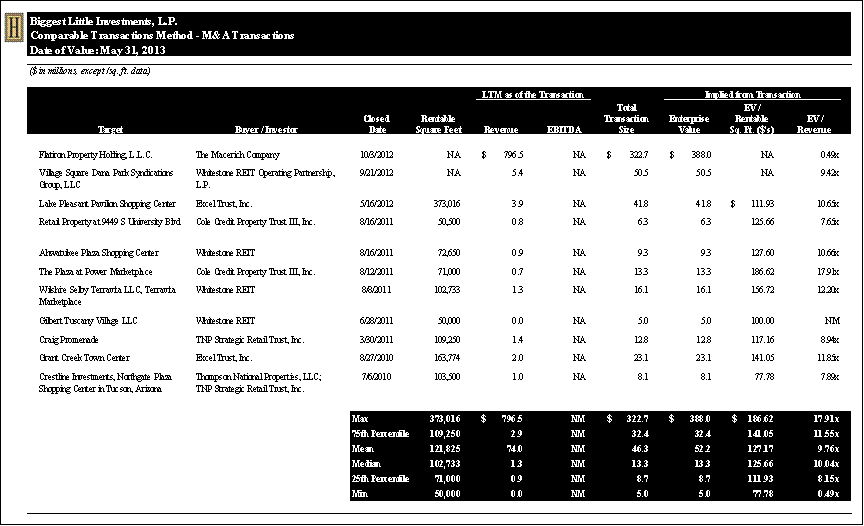
Discounted Cash Flow Method (continued)
| · | Houlihannotes that Management has indicated that its near-to-intermediate-term intentions for the Sierra property are to maintain the property under its current operations and attempt to increase its occupancy rates, but that its long-term intentions are to redevelop the property into a ‘lifestyle center’ once economic conditions in Reno and the rest of the country improve. |
| · | However, Houlihan also notes that neither such redevelopment, nor the cash flows and expenses to effect such, have in any way been incorporated into Management’s projections, as described and detailed above, since Management cannot reasonably estimate the timing when this would take place or the attendant cash flows. Houlihan considers this treatment consistent with Delaware court rulings not to include speculative scenarios. |
The second step within a DCF analysis is to discount the projected enterprise net cash flows, including the terminal value, to present value using an appropriate required rate or return(discount rate). The discount rate applied to the forecasted cash flows and terminal value must adequately reflect the nature and risk of the subject company and investment being valued, as well as the risk of the underlying cash flows.
| · | For Houlihan’s analysis of the Partnership, the appropriate discount rate is the Partnership’sWACC, calculated using estimates of a reasonable (i) cost of equity and (ii) after-tax cost of debt, which can both be based on data from a representative group of guideline public companies and considering the subject company’s actual data. |
| · | Houlihan developed the estimated cost of equity and cost of debt for the Partnership using data and factors relevant to the applicable macro-economy, thePartnership’s industry of operations, and the Partnership, as of the Date of Value. |
| · | Houlihan then weighted the components of the Partnership’s cost of capitalusing the Partnership’s actual capital structure (in this instance, the Partnership had no debt) to determine the estimated WACC for the Partnership.
|
Discounted Cash Flow Method (continued)
To develop the Partnership’s estimated cost of equity, Houlihan used the modified Capital Asset Pricing Model(“CAPM”), which can be summarized by the following formula:
ke = Rf + (RPm) * β + RPs+ RPu
Where:
ke = Cost of equity
Rf = Rate of return on a risk-free security
RPm = Equity risk premium for the market
β = Beta (Systematic risk; industry risk relative to the market)
RPs = Size premium
RPu = Company specific (unsystematic) risk premium
The cost of equity capital estimated by applying the modified CAPM formula, as well as Houlihan’s determination of the Partnership’s WACC, is presented in the following table.
Discounted Cash Flow Method (continued)
Houlihanbenchmarked the rate of return on a risk-free security by applying the yield of a representativeU.S. government bond. For this input, Houlihan relied upon the 20-year Constant-MaturityU.S. Treasury bond yield,as of the Date of Value, of 2.75%. The risk premium for the equity market can be calculated based on historical market returns in excess of estimated risk-free rates. Houlihan applied the 6.11% ‘Supply-Side’ long-horizon equity risk premium indicated by the2013 IbbotsonSBBI Valuation Yearbook. It is well established in the valuation industry that smaller companies require a higher rate of return. In Houlihan’s analysis of the Partnership, Houlihan applied a 3.81% size premium, based on the ‘Micro-Cap’ size category data (which includes deciles 9-10) published in the 2013 IbbotsonSBBI Valuation Yearbook. Within the CAPM formula, beta is a measure of the systematic risk of a particular investment relative to the market for all investment assets, which is often proxied by an index that contains a representative set of public companies to which the selected guideline public companies can reasonably be compared. |
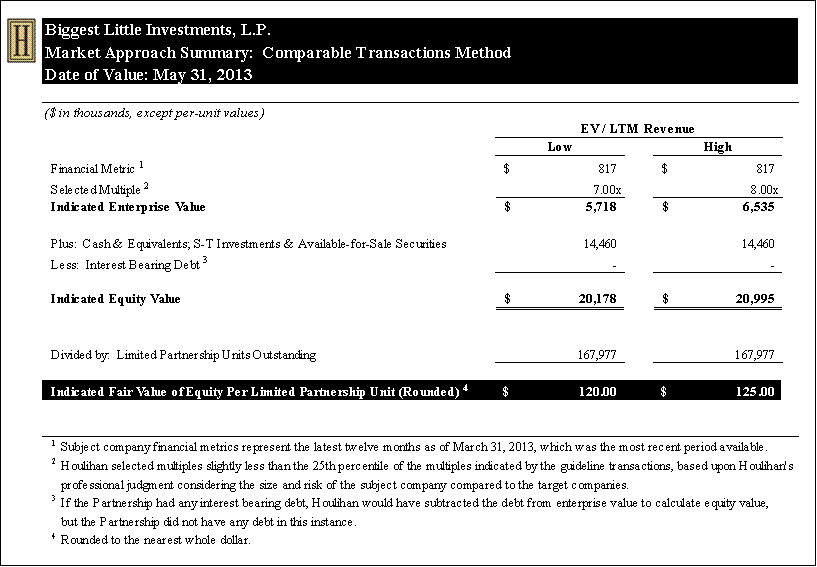
Discounted Cash Flow Method (continued)
To determine the beta applied in the modified CAPM for the Partnership, Houlihan determined a relevered beta based on the median beta coefficient of the guideline public companies (the same set of companies used in the Market Approach) relative to the S&P 500 index and the actual capital structure for the Partnership, as shown below.
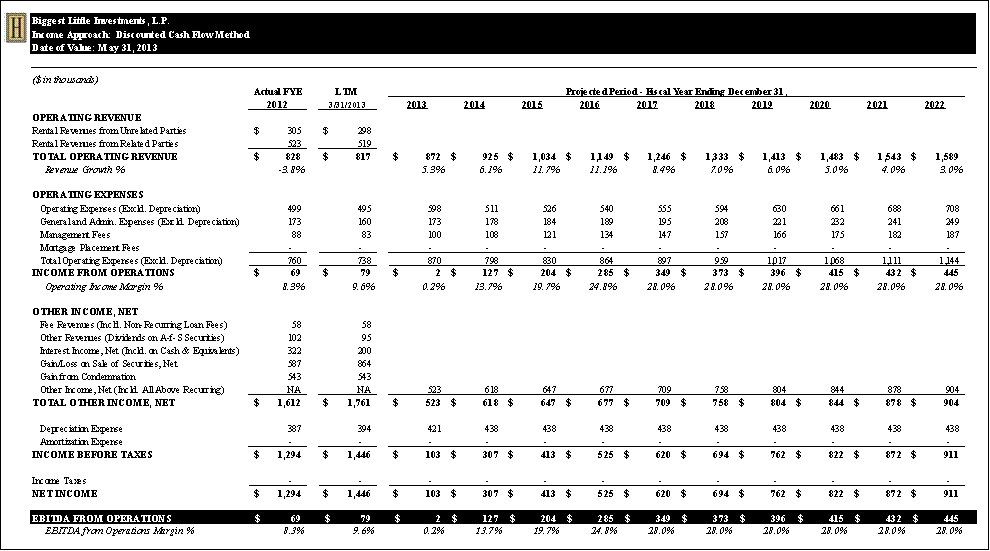
Houlihan then weighted the indicated required rates of return on equity and debt capital using the Partnership’s actual capital structure of 100.0% equity to total capital, and 0.0% debt to total capital. This WACC analysis resulted in an indicated discount rate of 12.6% for the Partnership.
Discounted Cash Flow Method (continued)
Next, Houlihan discounted the enterprise net cash flows for the years ending December 31, 2013 through 2022 applying thePartnership’s 12.6% estimatedWACC and a standard mid-year convention, typical to valuation practice.
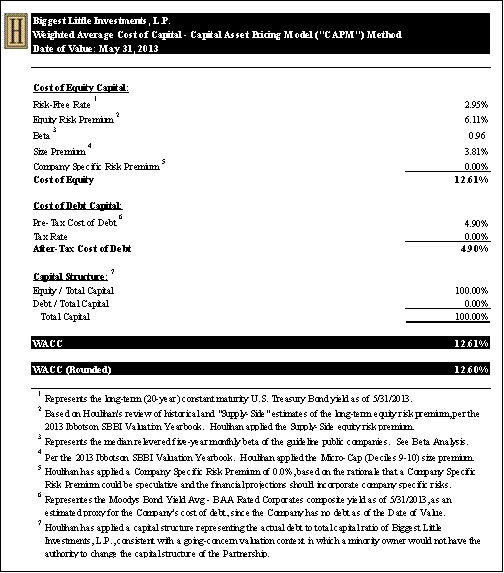
Houlihan then determinedthe Partnership’s terminal cash flow bygrowing the enterprise net cash flow projected for 2022 by the Partnership’sestimated long-term growth rate of 3.0%.
| · | Houlihan estimated the Partnership’s long-term growth rate based on the U.S. GDP outlook, an analysis of thereal estate operating company industry in which the Partnership operates, and company specific factors. |
Discounted Cash Flow Method (continued)
Houlihan capitalized the terminal cash flow to determine the Partnership’s terminal value by multiplying the terminal cash flow by the 10.4x capitalization multiple, calculated as: 1/(WACC - long-term growth rate) = 1/(12.6% - 3.0%). Houlihan then discounted the terminal value to its present value by applying the appropriate present value factor.
Next, Houlihan summed the present value of the cash flows and the terminal value to determine the enterprise value.After adding the Partnership’s cash andcash equivalents, short-terminvestments, andavailable-for-sale securities, Houlihan divided by the number of limited partnership Units outstanding and considered a sensitivity analysis of inputs to determine a reasonable range of indicated equity values for the Partnership, as presented in the following table.

Fairness Analysis Conclusion
Based on our analyses, as described above, our fairness analysis study has concluded that the Partnership’s indicated value of equity per limited partnership Unit, as of the date of this presentation, is within the range presented in the following table:

Conclusion
In determining the fairness of the Transaction, from a financial point of view, to BLI’s existing limited partnership Unit-holders, Houlihan considered the following factors.
| · | Houlihan considered the terms of the limited partnership Units, including the Partnership’s Redemption Offer, which allows the Unit-holders to sell their Units back to the Partnership for cash at a price agreed upon with the General Partner.Furthermore, Houlihan considered the fact that the Transaction is not a voluntary transaction in which the existingUnit-holders of less than 100 Units may choose to participate or not. Houlihan noted that Unit-holders of less than 100 pre-split Units would be required to participate in the Transaction, while holders of 100 or more pre-split Units would not participate (unless special circumstances or arrangements applied). |
| · | Houlihan alsoconsidered the going concern fair value of the Partnership indicated by several standard and generally accepted valuation methodologies, all using information provided by Management and certain research, such as industry reports, data from established financial research databases, and authoritative valuation literature. |
| o | Within the Guideline Public Company Method, Houlihan consideredinformation regarding certain guideline publicly traded companies considered reasonably comparable to the Partnership. |
| o | Within the Comparable Transactions Method,Houlihan considered information regarding certain publicly disclosed M&A transactions involving the purchase of target companies considered reasonably comparable to the Partnership. |
| o | Within the Discounted Cash Flow Method, Houlihan considered historical financial data for the Partnership obtained from SEC filings, as well as projected financial data provided by Management. |
| · | As detailed herein, the generally accepted valuation methodologies utilizedindicated ranges of fair values for the Partnership’s equity, on a per-Unit basis, thatapproximate the per-Unit consideration contemplated by the Transaction. Houlihan believes that this contributes to the Transaction being fair, from a financial point of view.
|
Conclusion (continued)
| · | In addition, Houlihan considered that, per the Partnership’s draft SEC Schedule 14C Information Statement regarding the Transaction, the Partnership estimates that, if the Transaction is completed, it would save approximately $107,000 annually in reporting and associated administrative costs. This savings would inure to the Partnership and its remaining Unit-holders, if the Transaction is completed, and would directly increase the Partnership’s net income and partners’ equity on a go-forward basis. Although the Partnership expects to incur approximately $97,000 in fees, if the Transaction is completed, and would be required to pay approximately $1.7 million to repurchase all of the Units anticipated to be subject to the Transaction, the reporting and administrative cost savings described above would serve to counteract the cash out-lays necessary to complete the Transaction. Further, if the Transaction is completed, the remaining Unit-holders’ proportional ownership of the Partnership would each increase, as described previously herein. Houlihan believes that these factors contribute to the Transaction being fair, from a financial point of view. |
| · | Houlihan considered the historical and current market prices of the Units. Houlihan noted that while there is no established public market for the Units and that Management is not aware of any recent private transactions for the Units, other than through the Redemption Offer, the Partnership has recently repurchased Units per the terms of the Redemption Offer, as discussed previouslyherein. Further, Houlihan’s analysis of the fairvalue of the Units, as describedherein, indicates that the fair value of the Units iswithin a reasonable range of the per-Unit pricesat which Units have recently been repurchased by the Partnership. In particular, the comparability of the per-Unitfair value range indicated by the Discounted Cash Flow Method to the range of recent per-Unitrepurchase prices indicates that a per-Unitvalue within a reasonable range of these indicated ranges would be fair, from a financial point of view. Houlihan believes that these factors contribute to the Transaction being fair, from a financial point of view. |
Conclusion (continued)
| · | Further, Houlihan considered the net book value, going concern value, and liquidation value of the Partnership. Houlihan determined that the net book valueand liquidation value of the Partnership do not have a direct impact on the fairness of the Transaction, because of the nature of the Units, including the fact that Delaware law indicates that ownership of theUnits entitle the Unit-holders to their pro-rata ownership share of the Partnership’s going concern value, making the Partnership’s net book value and liquidation valueonly of limited relevance to Houlihan’s Opinion. However, as discussed above, Houlihan believes that the going concern value of the Partnership contributes to the Transaction being fair, from a financial point of view. |
| · | Houlihan also considered the price paid for the Units in purchases by the Partnership or its affiliates over the previous two fiscal years. Houlihan noted that the Partnershiphas repurchasedUnits through the Redemption Offer at prices between $90.00 and $113.00 per Unit since September of 2009, with the most recent repurchaseoccurring at the highest price of $113.00 per Unit, as detailed herein. According to the Partnership’s draft SEC Schedule 14C Information Statement regarding the Transaction, during the previous twelve months, the range of repurchase prices paid by the Partnership was $103.00 to $113.00 per Unit.Houlihan believes that this contributes to the Transaction being fair, from a financial point of view. |
| · | In addition, Houlihan considered reports, opinions, or appraisals received by the Partnership relating to the value of the Transaction and its fairness, from a financial point of view, to the existing Unit-holders. Houlihan noted that Management represented that,other than Houlihan’s Opinion, the Partnership did not receive any reports, opinions, or appraisals relating to the Transaction. Therefore, Houlihan did not incorporate such into its fairness analysis or Opinion. |
Conclusion (continued)
| · | Finally, Houlihan considered firm offers during the preceding two years for the merger, consolidation, or sale of assets of the Partnership, or for securities of the Partnership sought in order to exercise control. Houlihan noted that, other than through the Redemption Offer discussed previously herein,Management is not aware ofanyfirm offers during the preceding two years to acquire the Partnership, any of itssignificant assets, or its securities. Therefore, Houlihan did not incorporate such into its fairness analysis or Opinion. |
Based upon the foregoing, Houlihan concluded that, as of the date hereof, the Transaction is fair, from a financial point of view, to the existing limited partnership Unit-holders of BLI.
Conclusion (continued)
It is Houlihan’s opinion that, as of the date hereof, the Transaction is fair, from a financial point of view, to the existing limited partnership Unit-holders of BLI.
Exhibit A: Guideline Public Company Descriptions
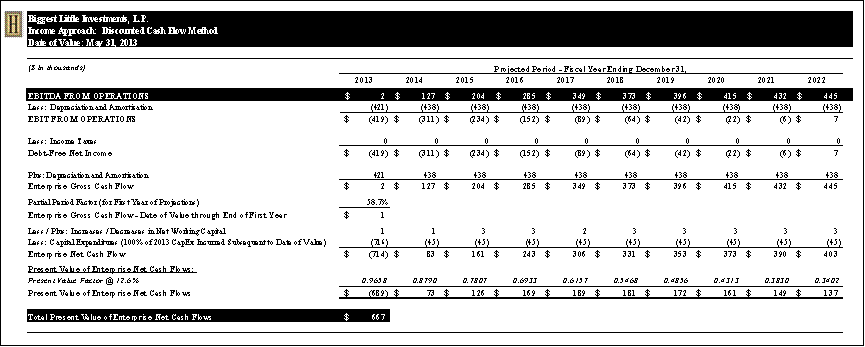
Exhibit A: Guideline Public Company Descriptions (continued)
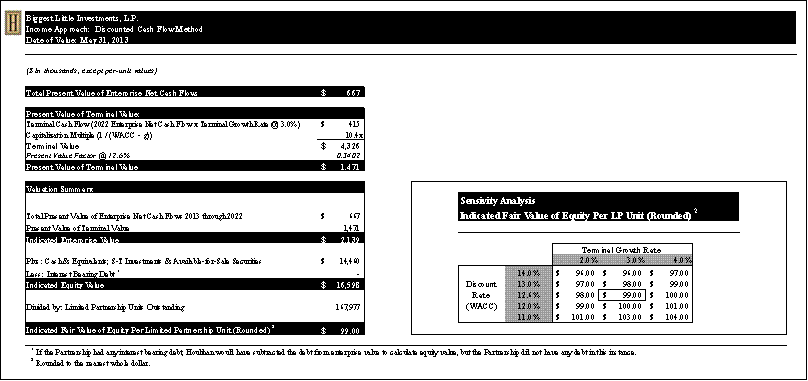
Exhibit B: Comparable Transactions Target Company Descriptions
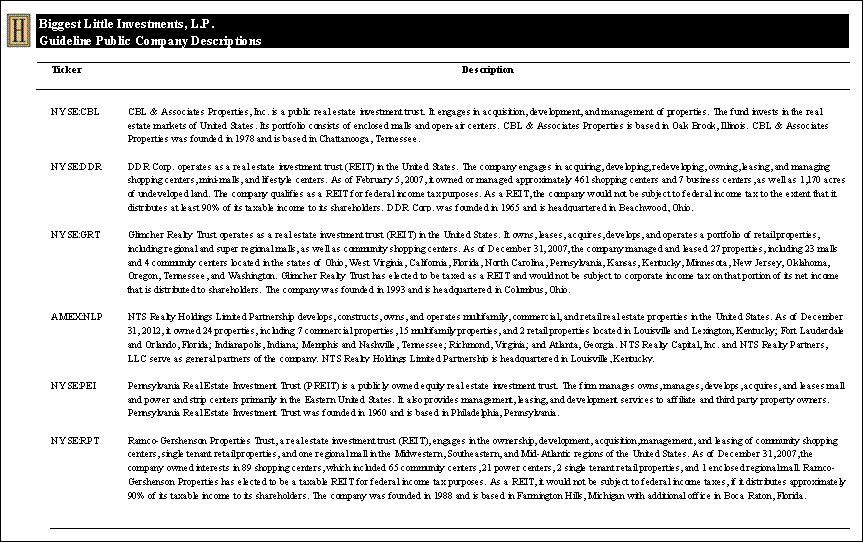
1.Source: The Partnership’s SEC form 10-K for the year ending December 31, 2012 and SEC form 10-Q for the quarter ending March 31, 2013.
2.Source: CLRSearch.com – Reno Demographics Summary (http://www.clrsearch.com/Reno-Demographics/NV/).

















